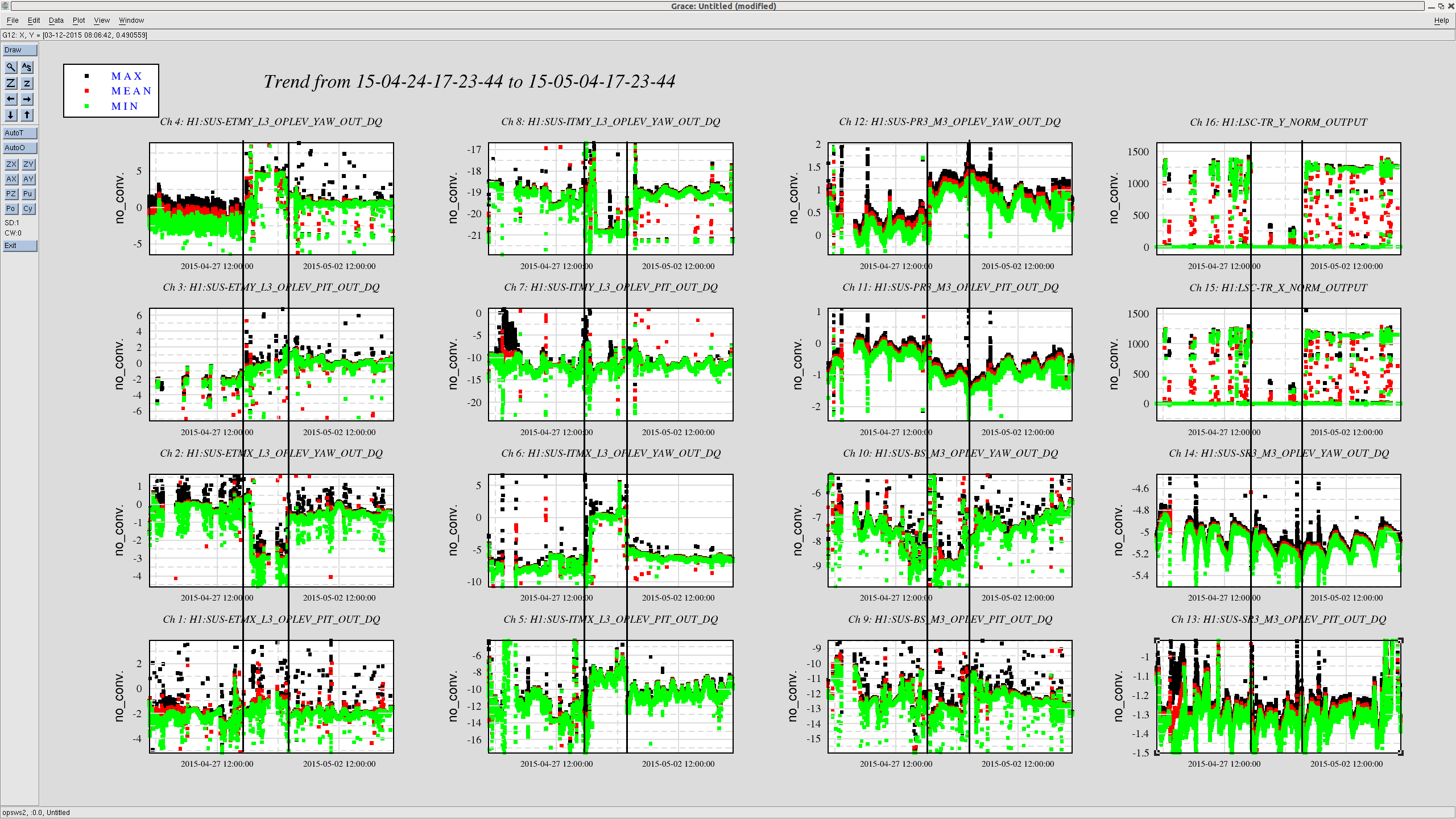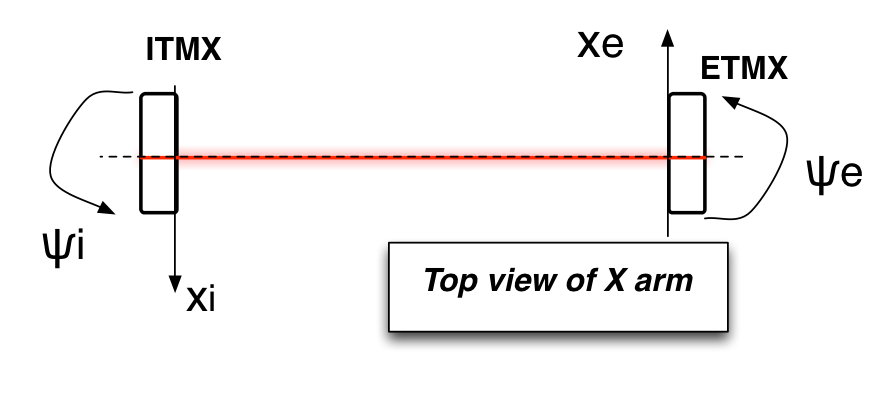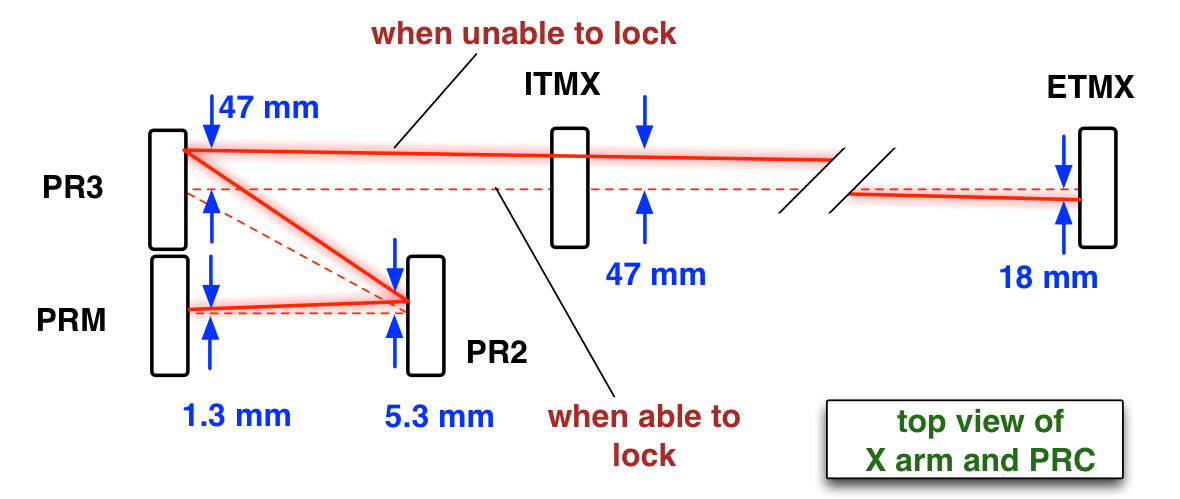There were a few days in the last week where we could not get the interferometer fully locked for some alignment-related reason. I studied what was going on in this period and came up with a hypothesis.
According to my hypothesis, the followings must have happened:
-
The beam spot on ITMX shifted horizontally by 4.7 cm.
- It is still unclear what introduced such a large offset. This could be related to the ITM camera activity, but no evidence.
-
The large displacement in the ITMX spot position resulted in some kind of clipping somewhere in PRC or Michelson.
- This caused a low recycling gain (alog 18125) and malfunction in PRC2 WFS loop in yaw (alog 18109).
These resulted in the dark days where we were unable to lock the interferometer.
[The unlockable days]
As shown in the above cartoon, we were unable to fully lock the interferometer between some time in the Tuesday 28th and Thursday 30th of April. I also noted alignment-related activities in the same viewgraph to see what kind of activity we did. It is shown that there was one activity right around the time when we started realizing difficulty in locking, namely removal of the software aperture mask on the ITMY green camera (alog 18108). Nonetheless, I don't think this triggered the unlockable days. As will be discussed in the later part of this alog, I believe that the cause is a large lateral shift of the spot on ITMX.
[Optics' angle in the unlockable days]
I attach two trend plots which show angle of various optics. They are 10days trend. I drew two vertical lines in each plot for encmpassing the dark days. Looking at the two plots on the upper right corner of the first plot, one can clearly see that TRX or TRY did not reach a high value, meaning we could not lock. Also, it is very clear that we had a different alignment in this particular period.
Even though some optics exhibited different alignment in pitch, most of the optics indicate that the alignment in yaw changed significantly. Therefore I neglect any misalignment in pitch hereafter and concentrate on misalignment in yaw.
[X arm alignment]
Since the Y arm behaves as a slave of the X arm from the point of view of the interferometer alignment, I assume that the Y arm alignment had been continueously adjusted properly so that the Michelson becomes dark and the beam spot on ETMY was adjusted to be at the center of it and so forth. In this way I limit the discussion to the X arm and PRC hereafter.
Here is a summary table of how much the relevant optics moved in yaw before and after the Tuesday 28th. The values were extracted from the two trend plots that I showed above.
| before Tuesday [urad] | after Tuesday [urad] | difference [urad] | sensor | |
| ITMX | -8 | 0 | +8 | oplev |
| ETMX | 0 |
-3 *2.74 (oplev calibration alog 18237) = -8.22 |
- 8.22 | oplev |
| TMSX | -229 | -235 | - 6 | witness sensor |
| PR3 | 271 | 275 | + 4 | alignment slider |
| PR2 | 3373 | 3398 | + 25 | witness sensor |
| PRM | 420 | 540 | + 120 | witness sensor |
| IM4 | -645 | -569 | + 76 | witness sensor |
Using the ITMX and ETMX angle differences, I estimated the difference in the spot position on ITMX and ETMX. I used the following matrix to compute the spot position:

The variables are defined as shown in the cartoon below.
Substituting the realistic values: L = 3994.5 m, ROC_itm = 1934m, ROC_etm = 2245 m, Psi_i = 8 urad and Psi_e = -8.22 urad, I obtain displacement of x_i = -4.7 cm and x_e = -1.8 cm. The beam axis should look like this:
Discussion of the DRMI part is held in the next section. Also, please note that in this analysis we can not estimate the absolute spot positions.
Displacement of 47 mm on ITMX is quite large. For example, one can compare it with the beam radius of the red light on ITMX which is about 53 mm. So it moved by almost half of the beam diamter.
Since we had nonideal behavior in PRC2 ASC loop, I am speculating that the large displacement on ITMX resulted in a clipping or something similar in PRC or Micheslon part and hence bad ASC signal.
According to error propagation, the spot position on the test masses are found to be very senstive to precision of the measured angles. For example, x_e would get an error of +/-1.2 cm if error of +/-0.5 urad is added on the ETMX angle. Nonetheless, I think the displacement of 47 mm on ITMX is believable as this is a relatively large number. On the other hand, the displacement of 18 mm on ETMX maybe fishy because of measurement error. Additionally, the green WFS servos must have steered the test masses such that the spot position on ETMX stays at the same position. Anyway, at this point it is unclear if ETMX actually moved by 18 mm.
One thing which makes me a bit suspicious about this caluclation is the angle of TMSX. As listed in the table, it moved by +6 urad. On the other hand, according to the analysis, the arm eigen axis obtained a rotation of about 16 urad which does not match the angle of TMSX by a factor of almost 3. I am not sure what this means.
[PRC alignment]
Doing a similar matrix approach in PRC, one can build a displacement-misalignment matrix as

where h_j is displacement and phi_j is misalignment. Subscript p stands for PRM, 2 for PR2, 3 for PR3 and i for ITMX. Subsitituting the difference in the measured angles as listed in the table, one can get
[hp h2 h3 hi] = [1.8 mm, -2.5 mm, 1.9 cm, -1.9cm]
which unfortunately contradicts what I said about the ITMX spot position. However, in principle, our initial alignment scheme should bring the PRC beam axis so as to match that of the arm cavity. Now, instead of simply substituting the measured values, I do a small tweak on PR3 angle. I add a magic number of 0.4 urad on top of the measured PR3 alignment. This results in displacements of:
[hp h2 h3 hi] = [-1.3 mm, 5.3 mm, -4.7 cm, 4.7 cm]
which agrees with the previous arm cavity discussion. I don't have any data to support this magical 0.4 urad on PR3, but I believe that it is not crazy to say that the calibration of the PR3 alignment slider has been off by 10 %. Anyway, if we believe in this result, this introduces a translation of 4.7 cm in the PR3-ITMX beam line as expected. Also the spot position on PRM did not move so mcuh as expected because it should be passively determined by the IMC pointing which I think is stable on a time scale of many days. Even though the spot on PR2 moved by 5.3 mm, I don't think this is big enough to let the beam hit the PR2 baffle to cause a clipping.
[Why the yaw alignment changed ?]
It is unclear why the yaw alignment changed so drastically during the period.
One might think that this was due to a wrong reference position on the ITMX green camera. However, according to the past alogs, there was no obvious activities associated with the ITMX green camera at around the time when we started having difficulty. Keita suggested me checking whether a limiter was on in some of ALS WFSs because it has been an issue which hindered the ALS WFS performance. Indeed both ALS_X_DOF2_P and _Y had a limiter on (see the attached conlog and trend), but the _Y_LIMIT value was set to 1e7 counts while _P_LIMIT was set to 10 counts, meaning Y_LIMIT was essentially not effective. This could cause some funny behavior in pitch, but it is still hard to believe that it introduced such a big offset in yaw.













